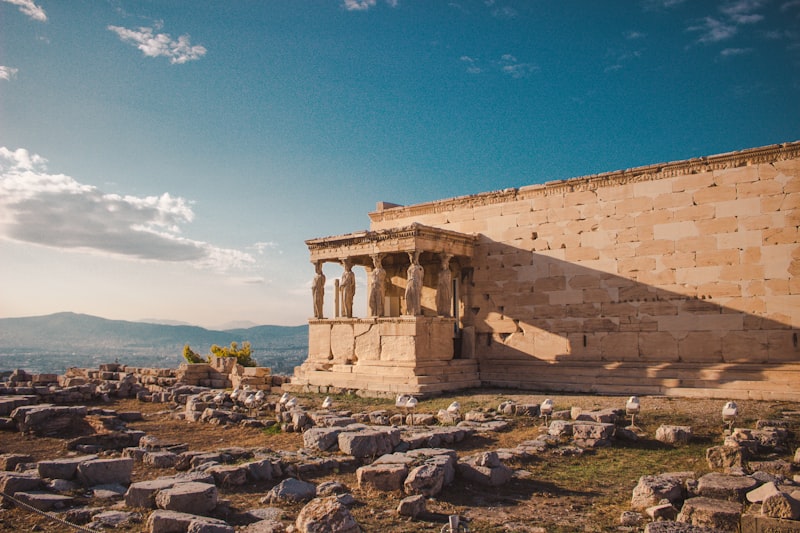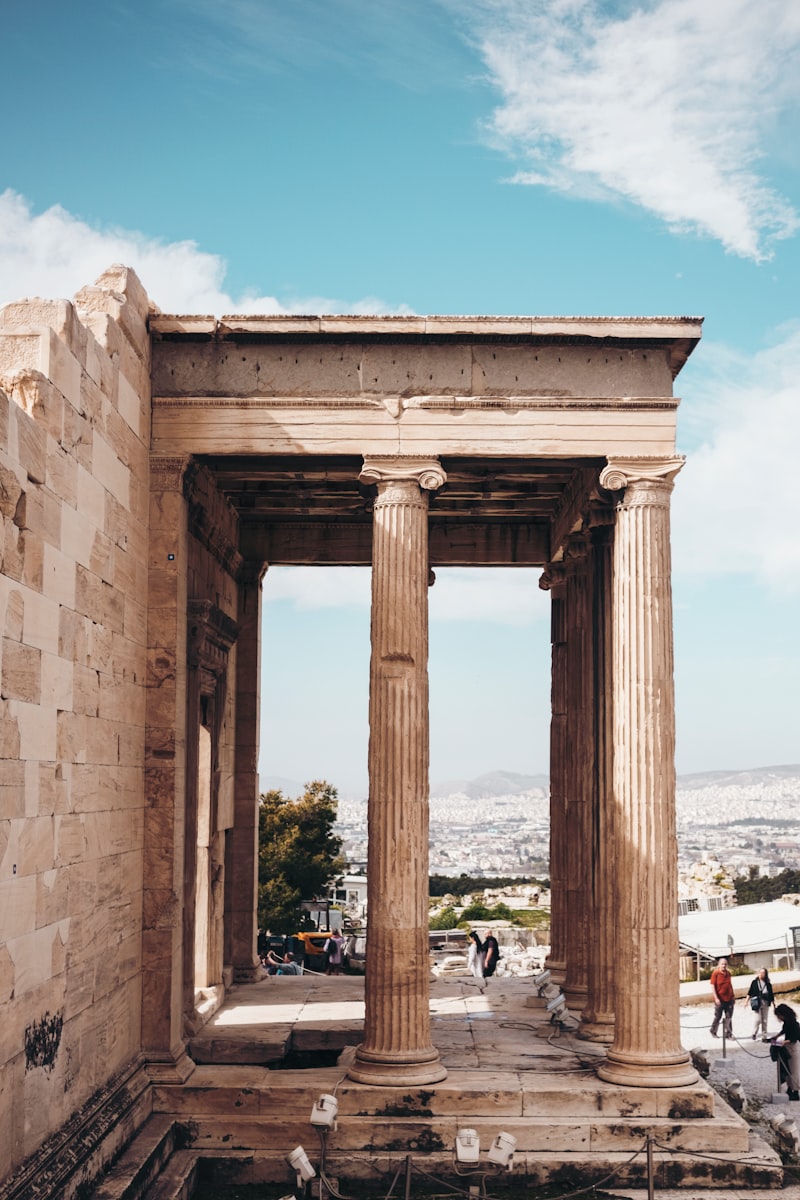The Acropolis stands majestically, its iconic Parthenon a symbol of Athenian democracy and the peak of classical Greek architecture. Built in the 5th century BC, it remains a testament to the city’s cultural and political prominence. As you gaze upon its Doric columns and intricate friezes, you can almost hear the echoes of ancient debates that shaped Western philosophy.
Nearby, the Temple of Olympian Zeus, one of the largest temples of the ancient world, stands in grandeur. Originally constructed in the 6th century BC and completed centuries later, it was dedicated to Zeus, king of the Olympian gods. Today, its towering columns offer a glimpse into the scale of ancient Greek engineering and religious devotion.
The Ancient Agora, once the heart of Athenian public life, invites visitors to wander through its ruins. Here, amidst temples, stoas, and civic buildings, Athenians engaged in commerce, politics, and philosophical discourse. It was here that democracy took its nascent form, where citizens gathered to debate and decide the fate of their city-state.
Venturing further, the Panathenaic Stadium stands as a marvel of ancient sports architecture. Originally built in the 4th century BC and restored for the first modern Olympic Games in 1896, it hosted athletic contests in honor of the goddess Athena. Standing on its marble tiers, one can almost feel the pulse of ancient competitions that celebrated physical prowess and honored the gods.
In Athens, history isn’t just preserved—it’s alive. Each site whispers tales of triumphs and tribulations, of gods and mortals, shaping the very fabric of Western civilization. As you explore these historical landmarks, you embark on a journey through time, where every stone has a story to tell and every visit leaves an indelible mark on your understanding of human history.
Unveiling Ancient Glory: Exploring the Hidden Gems of Historical Sites in Athens
Athens, the cradle of Western civilization, beckons with its rich tapestry of ancient history woven into every corner. Beyond the iconic Acropolis and Parthenon, this city harbors hidden gems that whisper tales of ancient glory.
Imagine strolling through the Ancient Agora, where Socrates once debated under the shade of olive trees. Here, the ruins of temples and stoas stand testament to a bustling marketplace that shaped Athenian life centuries ago.

Venture further to the Temple of Olympian Zeus, where colossal columns evoke the grandeur of a temple once hailed as the largest in Greece. Its fallen columns narrate stories of divine patronage and human ambition, offering a glimpse into ancient architectural marvels.
For those seeking a serene retreat, the National Garden of Athens unfolds like a verdant oasis amidst the urban landscape. Wander through its pathways shaded by towering palms and discover neoclassical monuments hidden among lush greenery, a perfect blend of natural beauty and historical resonance.
Delve into the lesser-known Kerameikos, an ancient cemetery where marble gravestones mark the final resting place of Athenian citizens. Here, history whispers through the wind, offering reflections on mortality and the enduring legacy of those who once walked these ancient streets.
Each of these sites not only preserves Athens’ rich past but also invites visitors to connect with history on a personal level. Whether you’re an avid historian or a casual traveler, Athens’ hidden historical sites promise an unforgettable journey through time.
Ready to uncover these treasures? Athens awaits, where every step reveals a new chapter in the story of civilization.
This article blends historical intrigue with an invitation to explore lesser-known sites in Athens, crafted to engage readers with its vivid descriptions and compelling narrative.
Time Traveling Through Athens: A Journey to its Oldest Historical Sites
Begin your adventure at the Acropolis, an icon of Western civilization perched majestically above the city. Here, the Parthenon stands as a testament to the glory of ancient Athens, its marble columns reaching towards the sky. As you gaze upon this marvel, you can almost hear the debates of Aristotle and Plato echoing through the Erechtheion, where the sacred olive tree of Athena once grew.
Venture further into the past at the Ancient Agora, the heart of Athenian public life for centuries. Here, amidst the ruins of temples and stoas, you can envision the bustling marketplace where Socrates questioned the youth of Athens. Wander through the Temple of Hephaestus, the best-preserved Doric temple in Greece, and feel the weight of history in its enduring columns.

No journey through ancient Athens is complete without a visit to the Temple of Olympian Zeus, a colossal structure that once housed the statue of Zeus, one of the Seven Wonders of the Ancient World. Nearby, Hadrian’s Arch stands as a gateway between past and present, commemorating the Roman Emperor Hadrian’s love for the city.
As you explore these sites, ponder the legacy of democracy born in these ancient streets. Picture the gatherings of citizens at the Pnyx, where decisions that shaped the course of history were made under the Athenian sky.
In Athens, time travel isn’t just a concept – it’s a tangible experience. Every step reveals layers of civilization, from the Golden Age of Pericles to the Roman conquest and beyond. Soak in the atmosphere of the Plaka district, where medieval charm meets ancient ruins, or marvel at the artifacts in the Acropolis Museum, a modern treasure trove of classical art and history.
Athens invites you to immerse yourself in its ancient past, to walk in the footsteps of philosophers and conquerors, and to discover why this city remains an eternal beacon of civilization.
Beyond the Acropolis: Discovering Lesser-Known Historical Treasures in Athens
Tucked away amidst the bustling modernity of Athens lies the Kerameikos Archaeological Site. Once an important burial ground and now an open-air museum, Kerameikos offers a poignant glimpse into ancient Greek funeral rites and artistic traditions. Strolling through its pathways, visitors encounter intricately carved gravestones and remnants of grand mausoleums, each telling stories of lives lived millennia ago.
A short distance from Kerameikos stands the Temple of Olympian Zeus, a monumental structure that once epitomized the grandeur of ancient Athens. Originally constructed in the 6th century BC, this colossal temple dedicated to Zeus was intended to be the largest in the ancient world. Today, its towering columns and scattered ruins serve as a testament to the ambitious architectural endeavors of the Athenians.
Venturing further south, the Stoa of Attalos beckons with its reconstructed marvels. Situated in the ancient Agora of Athens, this meticulously restored colonnade serves as a vibrant hub of ancient commercial and philosophical exchanges. Here, amidst the reconstructed Doric columns and bustling marketplace, one can almost hear the echoes of Socratic dialogues and bustling trade that once defined Athenian life.
For those seeking a panoramic view of Athens, Mount Lycabettus offers a breathtaking vantage point. Rising 300 meters above sea level, this limestone hill provides a sweeping panorama of the city below, from the Acropolis to the azure waters beyond. A climb to its summit or a leisurely ride on the funicular rewards visitors with unmatched vistas, especially magical during sunset or under a blanket of stars.
Athens, beyond its celebrated Acropolis, unveils a narrative of resilience, creativity, and cultural richness through its lesser-known historical gems. Each site whispers stories of ancient glory, inviting modern-day explorers to uncover the layers of history that continue to shape this captivating city.
Walking Through History: Must-Visit Historical Sites in Athens
As you wander through the Agora, once the heart of Athenian life, you can almost hear the echoes of philosophical debates and political discussions that shaped Western civilization. Here, Socrates and Plato walked among the bustling marketplace, sharing ideas that still resonate today.
A visit to the Temple of Olympian Zeus offers a glimpse into the grandeur of classical architecture. The towering columns, though weathered by time, evoke a sense of wonder at the scale of ancient engineering prowess.
For a more intimate encounter with history, delve into the National Archaeological Museum. Housing artifacts spanning millennia, it unveils the daily lives and mythologies of the Greeks through pottery, sculpture, and jewelry that transcend time.
Venture further to the Panathenaic Stadium, where the first modern Olympic Games were held in 1896. Stand on the track where athletes once competed in ancient times, feeling the spirit of competition that has endured for centuries.
No journey through Athens is complete without a visit to the Erechtheion, where the Caryatids stand gracefully, supporting the temple dedicated to Athena and Poseidon. These maidens-turned-columns symbolize strength and beauty in harmony, a fitting metaphor for Athens itself.
In Athens, every step is a discovery, every corner a testament to the ingenuity and artistry of the ancient world. Whether you’re an avid historian or simply captivated by the allure of the past, Athens promises an unforgettable journey through time.
From Antiquity to Modernity: The Evolution of Historical Sites in Athens
Athens, the cradle of Western civilization, stands as a testament to the enduring legacy of ancient history blending seamlessly with the vibrancy of modernity. Nestled amidst the bustling cityscape are remnants of a glorious past that continue to captivate visitors from around the globe.
One of the most iconic sites in Athens is the Acropolis, a symbol of ancient Greek achievement and architectural prowess. Perched atop its rocky outcrop, the Parthenon, dedicated to Athena, the goddess of wisdom and warfare, remains a beacon of classical Doric architecture. Its marble columns and intricate friezes depict scenes from Greek mythology, offering a glimpse into the artistic and cultural zenith of ancient Athens.
Beyond the Acropolis, the ancient Agora served as the heart of Athenian civic life. Here, philosophers like Socrates and Plato engaged in intellectual discourse amidst bustling markets and civic buildings. The Temple of Hephaestus, dating back to the 5th century BC, stands remarkably preserved, showcasing the skill of ancient Greek craftsmen.
As Athens evolved through the centuries, so too did its architectural landscape. The Roman Agora, established under Julius Caesar and Augustus, introduced Roman architectural elements while preserving Greek traditions. The Tower of the Winds, an ancient clocktower and weather vane, stands as a testament to Roman engineering ingenuity.
The Byzantine era saw Athens transformed into a center of Christian worship, with churches and monasteries dotting the cityscape. The Church of Panagia Kapnikarea, dating to the 11th century, blends Byzantine and Romanesque architectural styles, reflecting the city’s religious and cultural diversity.

In more recent centuries, Athens experienced Ottoman rule, leaving its mark on the city’s architectural fabric. The Ottoman Empire’s influence is evident in structures like the Fethiye Mosque, a former church converted into a mosque, showcasing the city’s multicultural heritage.
Today, Athens continues to evolve as a modern metropolis while preserving its rich historical tapestry. The juxtaposition of ancient ruins against a backdrop of contemporary buildings serves as a reminder of the city’s enduring legacy and its ability to embrace the past while looking towards the future. As visitors explore its streets, they walk through layers of history, each telling a story of Athens’ remarkable journey through time.
Architectural Marvels: Iconic Structures of Historical Significance in Athens
The Acropolis, an enduring symbol of ancient Greece, reigns supreme atop a rocky outcrop overlooking the city. Its crown jewel, the Parthenon, stands tall and proud, a Doric masterpiece dedicated to Athena, the goddess of wisdom and war. Built in the 5th century BC, its architectural precision and aesthetic harmony continue to captivate visitors from around the globe.
Nearby, the Temple of Olympian Zeus stands as a colossal reminder of the grandeur of ancient Greek architecture. Initially conceived in the 6th century BC but completed centuries later by Roman emperors, its towering Corinthian columns once housed a colossal statue of Zeus, a testament to the city’s reverence for its gods.
Venturing into the heart of Athens, one encounters the Ancient Agora, a bustling marketplace and civic center in antiquity. Here, the stately Temple of Hephaestus stands as one of the best-preserved Doric temples in Greece. Dedicated to Hephaestus, the god of craftsmanship, it showcases the precision and symmetry characteristic of classical Greek architecture.
Not far from the Agora lies the Panathenaic Stadium, an architectural gem reborn in marble. Originally built in the 4th century BC and renovated for the inaugural modern Olympic Games in 1896, its horseshoe-shaped design echoes the ancient Greek love for athletic prowess and competition.
As dusk settles over Athens, the National Library of Greece and the Athens Trilogy come alive, their neoclassical facades illuminated by the warm glow of streetlights. These 19th-century structures, with their intricate detailing and imposing presence, pay homage to Greece’s classical past while embracing the ideals of a modern era.
Athens, a city steeped in history and mythology, continues to mesmerize and inspire with its timeless architectural treasures. Each structure, from the towering columns of the Parthenon to the serene beauty of the Temple of Hephaestus, offers a glimpse into the soul of a civilization that shaped the course of Western history.
Frequently Asked Questions
What are some lesser-known historical gems in Athens?
Discover lesser-known historical gems in Athens beyond the famous landmarks. Uncover hidden archaeological sites like the Roman Agora and the Kerameikos Cemetery. Explore the charm of Anafiotika, a scenic neighborhood under the Acropolis. Delve into the Museum of the City of Athens for unique insights into local history. These sites offer a rich tapestry of Athens’ lesser-explored historical treasures.
What are the must-visit historical sites in Athens?
Discover the essential historical sites in Athens with our guide. Learn about iconic landmarks like the Acropolis, Parthenon, and Ancient Agora, offering insights into Greece’s rich history and culture.
How old are the historical monuments in Athens?
Discover the age of Athens’ historical monuments, tracing back centuries to ancient civilizations. Explore their rich history dating back to antiquity.
Are there guided tours available for Athens’ historical sites?
Discover guided tours for Athens’ historical sites to enhance your exploration. Learn from expert guides about the city’s rich history, including iconic landmarks like the Acropolis and ancient ruins. Ensure an insightful journey through Athens’ cultural heritage.
How can I plan a historical tour of Athens?
Learn how to effectively plan your historical tour of Athens with our concise guide. Discover essential landmarks, museums, and ancient sites to visit. Get practical tips on transportation, ideal times to visit, and must-see historical artifacts.


